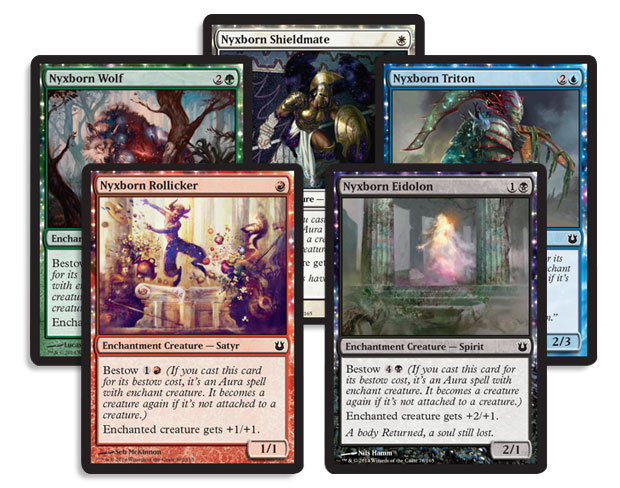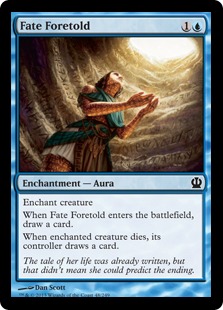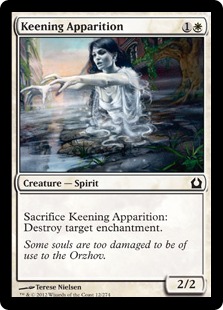Last time, I discussed the circumstances that led me to start creating trophies for
Monday Pauper Deck Challenge and then posted links to all the tools I use in my process. As I mentioned last time, my hope is that through reading this post others, possessing greater artistic talent than myself, will recognize just how woeful my efforts are and take over this job from me. Or, failing that, at the least others will be able to step up and create trophies for other Player Run Events on PDCMagic.
For the sake of this post, I will be creating a trophy for
SPDC 20.01. You reference, you can view the winning decklist
here.
The first step is to pick the card art for the trophy. The best source for this is
magiccards.info, which has larger scans of every Magic card available. For this season, we have already determined that White Weenie decks will use art from
Auramancer, so that's the art that I will download.
Next, I open up the template file I referenced last time for Standard, which has a default name of standardblank.psd. Opening this in Paint.net, you arrive at a screen like this:
Now, we need to input the card art into the template. Select "File, Open" and click on the Auramancer artwork. Using the rectangle select tool, select only the artwork itself, then click on "Edit, Cut." In the upper-right hand corner, click back to the trophy template.
Next, select "Edit, Paste into New Layer." In the dialog box that pops up, select "Keep canvas size." By default, it will paste the artwork into the lowest layer, which means that it may not be visible at this moment. In the "Layers" window on the right, unselect the check boxes for all of the other card art until the picture of the Auramancer is visible. Your screen should now look something like this:
Now then, we want to slide the artwork around until it looks right. This mostly personal preference, but it does make a difference.
At this stage, you can also tweak the artwork itself by increasing the Brightness and/or Contrast, or even tweak the Hue. You can find all of these options under "Adjustments" in the upper menu. I usually won't alter any of these more than 5-10 points or so. It's subtle, but it's often worth spending a few minutes playing with these to get a better result. In this case, I bumped up the Contrast by 10, decreased the Brightness by 10, and increased the Hue by 10.
With that, the hard work is already done. So now we need to take out the previous text and add in the right text for this event. Back in the Layers window, click on the "Deck" layer. Then, using the Eraser tool, remove the previous deck name. You'll notice that with this layer selected, none of the other elements are effected.
Now, to replace it. Select the Text tool, then select your Font and Size from just below the Menu Bar. For this trophy, I will select the "Arial Black" font at size 20. Next, select the color white. Then, type out the deck name ("White Weenie"). You'll notice right away that with the light card artwork, the font is difficult to read. To fix this, we want to create an outline around the text.
The easiest way to do that is to create a new layer just below the "Deck" layer. For reference, rename this "Deck Outline." Then, in this new layer, once again use the Text tool to write the deck name, with the same font and size, but with the color black. Once you type it out, you can actually move the letters around until it acts as an outline for the deck name.
Use this same process to change the Event and Player layers to the corresponding information. Typically you use a different font for these. I'll go ahead and use the "Elegance" font. If you're following along at home, the Event is SPDC 20.01 and the Player is xelz. When you finish, your trophy will look something like this:
Not too shabby, but there's a couple nice features we can add.
First off, let's add the most recent expansion symbol to make it clear when this deck was from. To do this, you want to find the Theros Common Expansion symbol. Once you have a copy of it, open it, resize it to 20 x 20, then copy/paste it into the "Symbol" layer. To make it transparent, simply double-click the "Symbol" layer, then drop the "Opacity" down to 200. Using the "Move Selected Pixels" tool, you can move the symbol around until it looks appropriate.
Second, let's add the White Mana symbol to the trophy. In Paint.net, open up the Mana-Symbols file that I linked to last time. Using the "Ellipse Select," select just the White Mana symbol, copy/paste it into a new document, resize it to 20 x 20, then paste it into the trophy template as a new layer. Rename this layer "Mana Symbols," then move around the symbol to where you want it.
At this point, you can add any additional tweaks here that you wish. Typically for SPDC I include a long line across the Player name and Event name to help differentiate it from MPDC trophies. So, create a new layer called "Line," then draw a straight line using the "Line/Curve" tool. I made mine White with a width of 3.
Finally, you can tweak the placement of any particular element by using the "Move Selected Pixels" tool with the proper layer selected.
And, at last, you have the final product I previewed at the top of this post. Just two last steps. First, go ahead and save the template, to speed things along next time. Second, you need to save the template as a gif file to upload. Click "File, Save As," select "GIF" in the "Save as type" box, and give it a name. When the next window pops up, just select "OK," then select "Flatten" on the next window. And there you have it! A .gif file ready to be uploaded to PDCMagic!
Hope you enjoyed this tutorial, and that it inspires you to create your own trophies. See you next time!


















